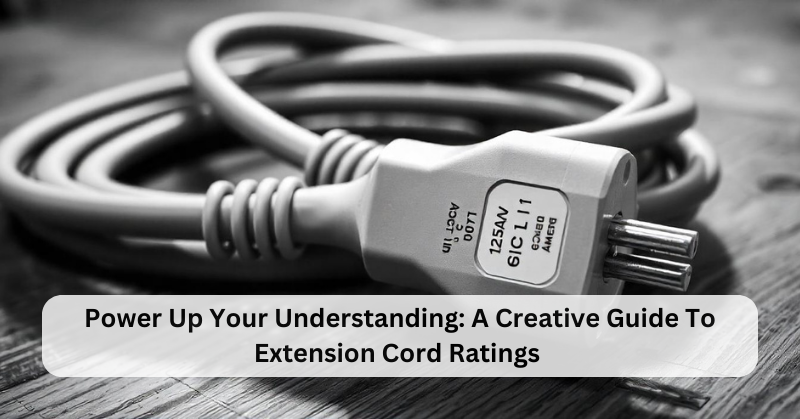

Power Up Your Understanding: A Creative Guide To Extension Cord Ratings
Extension cords are simple tools that keep homes, offices, and outdoor areas running. However, not all extension cords are created equal. Thus, using the wrong one can result in overheating, damage to your devices, or even serious safety hazards. That's why knowing how to choose the right cord is essential.
Furthermore, different operations require different types of cords. Thus, a light-duty cord will do fine for a lamp or even a phone charger, whereas heavy machinery or outdoor projects require significantly stronger cords.
Consequently, the wrong type of cord selection will lead to underpowered tools, excessive wear, or worse, failure and safety risks. Therefore, one must understand how these elements interact for safety and efficiency.
Here, we consider all you need to know to make wiser and safer choices about extension cords in any situation.
Understanding Extension Cord Ratings

The rating of an extension cord is given by its capacity, which is determined by its gauge, length, and material.
For instance, a 12-gauge cord extension can support larger loads than a 16-gauge cord. This will affect the performance when it comes to the actual wire's length. If longer, the voltage dropping will happen to a level that, at one time, electric power getting it would not be acquired to drive a device effectively and efficiently as it was intended by design.
Therefore, when choosing an extension cord, one also needs to check the voltage rating on the package. The rating will often indicate the maximum wattage and amperage the cord can safely handle.
Key Elements of Extension Cord Ratings
Below are some key elements of extension cord ratings that you should know about;
1. Wire Gauge (AWG)
The wire gauge, measured in American Wire Gauge (AWG), indicates the thickness of the cord’s internal wires. Here’s what you need to know:
-
Lower Numbers = Thicker Wires: A 12 AWG cord is thicker and can handle more current than a 16 AWG cord.
-
Higher Numbers = Thinner Wires: Thinner wires (e.g., 18 AWG) are suitable for low-power devices.
|
Wire Gauge (AWG) |
Maximum Amps |
Common Applications |
|
18 AWG |
10 Amps |
Lamps, fans, and small appliances |
|
16 AWG |
13 Amps |
Power tools, small kitchen devices |
|
14 AWG |
15 Amps |
Heavier-duty tools and appliances |
|
12 AWG |
20 Amps |
High-powered equipment |

2. Cord Length
The length of a cord affects performance because longer cords have more resistance, which cuts down the power delivered; this is what is called voltage drop. Furthermore, shorter cords are better for high-power devices since they lose less energy, while longer cords work better for lightweight or low-power devices. For instance, some 16 AWG cords that work fine at 25 feet may not be adequate for 100 feet, even with the same device.
3. Amperage Rating
The amperage rating of an extension cord determines the amount of current that can safely flow through it, and drawing more current than this rating leads to overheating and thus presents hazards. To ensure the user is protected, it is necessary to match the cord's amperage rating to the requirements of the device it serves. Always check the label or packaging to determine the maximum amp rating of the cord before use.
4. Voltage Rating
Voltage ratings are a critical factor to consider when selecting an extension cord. Most household extension cords are designed for a standard voltage of 120V, typical for U.S. homes. In contrast, industrial or outdoor extension cords are often rated to handle higher voltages, such as 240V, commonly used in heavy-duty or industrial applications.
5. Cord Type and Insulation
The cord’s outer jacket and insulation determine its durability and suitability for specific environments. Look for letters printed on the cord to decode its type:
|
Letter |
Meaning |
|
S |
General-use cord |
|
J |
Junior-grade insulation (300V) |
|
T |
Thermoplastic insulation |
|
E |
Thermoplastic elastomer insulation |
|
W |
Rated for outdoor use |
|
P |
Parallel wire construction |

Choosing the Right Extension Cord: Practical Scenarios
The following are some practical applications of extension cords;
1. For Power Tools
When using power tools such as drills or saws, it’s important to choose a 14-gauge or a 12 gauge extension cord, particularly for cords longer than 25 feet. These tools require more power, and a thicker gauge ensures they operate efficiently and safely.
2. For Outdoor Use
For outdoor use, you would want to select the right extension cord that is robust enough to deal with different weather conditions. Look for "W" labeled cords, and for powering high-powered tools or appliances, opt for a thicker gauge such as 12 AWG or 14 AWG.
3. For Heavy-Duty Applications
Heavy-duty equipment, like air compressors or space heaters, usually requires heavy-duty extension cords. It is, therefore, imperative to ensure that the cord is appropriate for both the length and power requirements of the equipment if safe and efficient operation is to be ensured.
4. For Household Use
You will want to use a 16 AWG cord rated for 13 amps for most household purposes, which should be adequate for lamps, fans, or small kitchen appliances. But for larger appliances, such as a refrigerator, you must pick the right extension cord to manage that power consumption.

Powering Safely with the Right Extension Cord
Extension cords are a great deal, considering one of the major methods of safely supplying power to devices and equipment. Therefore, proper selection of an extension cord requires understanding its rating, proper selection for the job at hand, and attention to factors such as length and environmental use.
Moreover, using the proper cord is efficient and safe because it prevents overheating of your device and triggers electric fires.
